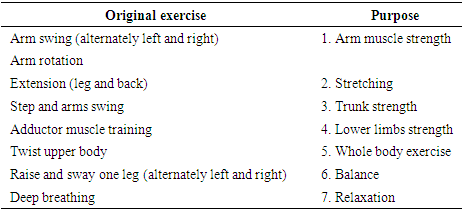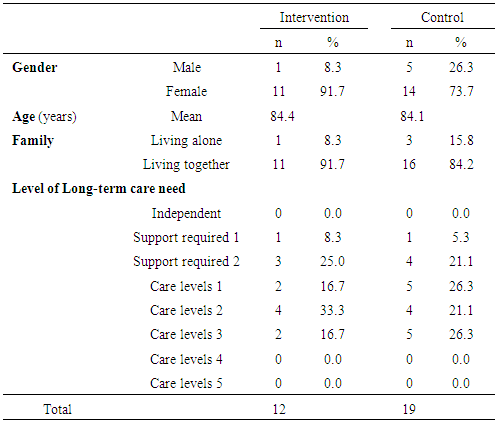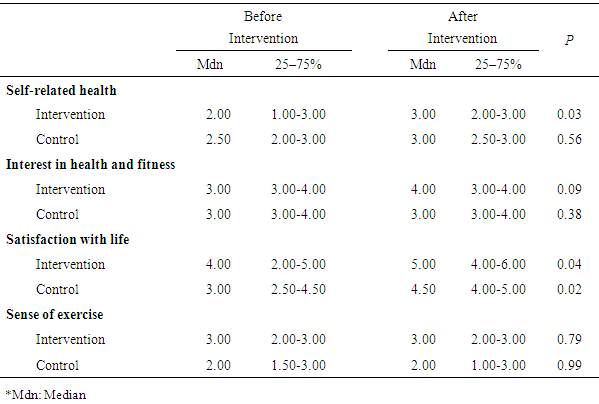-
Paper Information
- Paper Submission
-
Journal Information
- About This Journal
- Editorial Board
- Current Issue
- Archive
- Author Guidelines
- Contact Us
International Journal of Nursing Science
p-ISSN: 2167-7441 e-ISSN: 2167-745X
2017; 7(2): 44-48
doi:10.5923/j.nursing.20170702.02

The Effect of Exercise with Music on the Subjective Well-Being of Nursing Care Users
Kumi Watanabe 1, 2, Manabu Sakayori 1, Koichi Uruno 1, Mitsuko Uruno 1, Tokie Anme 2
1Social Welfare Corporation Houkokai, Koga, Ibaraki, Japan
2Graduate School of Comprehensive Human Sciences, University of Tsukuba, Tsukuba, Ibaraki, Japan
Correspondence to: Tokie Anme , Graduate School of Comprehensive Human Sciences, University of Tsukuba, Tsukuba, Ibaraki, Japan.
| Email: |  |
Copyright © 2017 Scientific & Academic Publishing. All Rights Reserved.
This work is licensed under the Creative Commons Attribution International License (CC BY).
http://creativecommons.org/licenses/by/4.0/

This study aimed to examine the effect of a physical exercise program set to music on the subjective well-being of elderly users of day care services. Participants were 31 elderly people who used day care services. They were separated into intervention and control groups. Subjective well-being was assessed using measures of self-rated health, subjective physical fitness, interest in health, and satisfaction with life; all of the measures were administered at baseline and after 12 weeks. We noted significant improvements in self-rated health (p = 0.03) in the intervention group. The results indicated that physical exercise set to music can improve aspects of subjective well-being among elderly users of nursing care services. Physical exercise set to music might be useful and effective for elderly users of nursing care services not only because of its physical benefits but also because of its benefits to subjective well-being.
Keywords: Nurses, Exercise intervention, Long-term care
Cite this paper: Kumi Watanabe , Manabu Sakayori , Koichi Uruno , Mitsuko Uruno , Tokie Anme , The Effect of Exercise with Music on the Subjective Well-Being of Nursing Care Users, International Journal of Nursing Science, Vol. 7 No. 2, 2017, pp. 44-48. doi: 10.5923/j.nursing.20170702.02.
Article Outline
1. Introduction
- The aging of the general population has made addressing age-related health problems an urgent issue worldwide. Population aging has been linked to an expected rise in the number of elderly individuals with disability. Aging and its related disability (e.g., chronic disease and declining function) have been shown to negatively influence various aspects of subjective well-being, such as self-rated health and satisfaction with life [1, 2]. Declines in subjective well-being, in turn, can lead to depression and accelerated functional decline, making it necessary to devise ways of maintaining subjective well-being among elderly individuals with declining function [3, 4].One way to prevent functional decline is physical exercise, which has proven to have numerous beneficial effects for elderly individuals. There is robust evidence that exercise interventions are effective in improving several health and functional indicators, such as prevention of declining function [5], falls [6], and mortality [7]. Notably, some reported that exercise set to music may be more effective than exercise alone. For instance, a recent randomized controlled trial showed that the cognitive function of elderly individuals was improved to a greater degree after an exercise intervention accompanied by music than after the same exercise without music [8]. Another randomized trial showed that music and movement therapy had a clear effect on various psychological, physical, and physiological indices among elderly women, and these effects were significantly improved compared to a control group who engaged in exercise without music [9]. According to these results, music might significantly enhance the beneficial effects of exercise. Furthermore, music itself, when employed as music therapy in nursing care, has been broadly reported to have therapeutic effects on elderly adults [10]. However, when paired with exercise, music might also improve adherence to [11] and reduce the perceived exertion of physical exercise [12]. Additionally, music appears to stimulate physical activity among younger adults [13].In addition to benefitting functional status, exercise interventions can influence happiness and psychological status among elderly individuals. For instance, an 8-week physical activity intervention program was found to enhance elderly individuals’ happiness [14]. Among elderly individuals living in nursing homes, a physical exercise intervention was found to improve subjective ratings of pain and psychological well-being [15] while a 12-week dance intervention appeared to improve depressive symptoms [16]. People with poor functional status tend to report lower levels of well-being and greater levels of depression [17]. Considering these points and those regarding the effect of exercise, a physical exercise intervention may be particularly helpful for elderly individuals with functional decline. Based on this background, exercise set to music may be an effective intervention for improving the well-being of elderly individuals utilizing nursing services. However, there remains little evidence demonstrating the precise effect of an exercise intervention set to music on subjective well-being among elderly people. Within this aging society, an intervention that can effectively improve elderly individuals’ subjective well-being even after functional decline would be a considerable benefit to nursing care (particularly home care). Thus, the current exploratory study was conducted to determine the effects of an exercise program involving music, which was developed as part of a nursing care service, on subjective well-being.
2. Materials and Methods
2.1. Participants
- Participants were recruited from two facilities: a day care centre and a rehabilitation centre in Social Welfare Association A, Ibaraki prefecture, Japan. Both facilities are covered by the Japanese long-term care insurance system to provide day care for who were registered as disability. 31 elderly individuals who regularly used the service were asked to participate in the current study. Since each participant only utilized the day care/rehabilitation service on a certain day of the week, we conducted the exercise and music intervention on specific days (Tuesday and Friday) and recruited participants who arrived at the centres on those days as the intervention group. Users of the service on other days were allocated to the control group. Intervention group participants took part in the exercise program set to music (n = 12), while control group participants conducted group recreation as usual (n = 19).
2.2. Development of the Exercise Program Set to Music
- An executive committee comprising 9 staff members of Social Welfare Association A devised the exercise program set to music. The executive committee devised the program (including the music and lyrics).The music had a slow tempo (70 beats per minute) to make it suitable for exercise involving elderly people, and was 32 bars (4 bars × 8) to ensure that it fit with the structure of the exercise. Lyrics were created via input from local residents, users of Social Welfare Association A, and staff of the association, and were edited by an executive committee member. The lyrics centred on language aiming to cultivate a sense of community and reflect the characteristics of the region.The exercise program content was devised by an exercise therapist to ensure that it is effective and can be easily done in groups. The specific exercises included whole-body stretching, upper and lower body exercise, gross motor exercise, and exercise to deep breathing. Overall, 40 types of movement were proposed by the exercise therapist. Then, a physical therapist, occupational therapist, social worker, and care worker from Social Welfare Association A selected 8 movements in consideration of effect and feasibility (Table 1).
|
2.3. Procedure
- To evaluate the effect of the exercise with music intervention, a researcher interviewed participants at baseline and 12 weeks later. These interviews each took approximately 30 minutes on a particular day. The exercise program itself was held at a community space in each study facility. Participants in the intervention group stood in a circle during the exercise program. During the intervention program, a health professional watched over participants to check their health conditions.
2.4. Measurements
- We included demographic information collected by the social welfare association, which included participants’ age, gender, level of long-term care. The level of long-term care referred to the participant’s certification of care needs based on the results of a screening of their mental and physical condition by a long-term care approval board and the opinion of a regular doctor. There are 7 levels, with higher levels indicating a more severe condition. The main outcome measure, subjective well-being is operationally defined as satisfaction in life and health which show the domain satisfaction, one of the aspect of subjective well-being [18]. Subjective well-being is measured using 4 items corresponding to the following: self-rated health, interest in health, daily effort to engage in physical exercise, and satisfaction with life. Self-rated health was assessed with the question, ‘What do you think about your health?’ Participants were given 4 options: ‘very good’, ‘good’, ‘fair’, and ‘poor’. Satisfaction with life was scored with a 7-point scale ranging from 0 (lowest satisfaction) to 6 (highest satisfaction). Frequency of physical exercise was assessed with ‘How often do you try to do exercise in daily life?’ Response options included ‘always’, ‘sometimes’, and ‘never’. Finally, interest in health was assessed with ‘How interested are you in health promotion and health maintenance?’ Response options included ‘highly interested’, ‘fairly interested’, ‘not very interested’, and ‘not interested’.
2.5. Statistical Analysis
- The effect of the exercise with music intervention was assessed using the Wilcoxon singed ranks test to test the difference in subjective well-being measures for each group before and after the intervention. All statistics analyses were performed using SAS version 9.3.
2.6. Ethical Consideration
- This study was approved by the ethics committee of the University of Tsukuba (841). All participants provided written consent prior to study participation.
3. Result
- Participants’ characteristics are shown in Table 2. Control group participants’ average age was 84.4 years, while that of intervention group participants’ age was 84.1 years. We noted no significant differences between the intervention and control groups in any of the characteristics.
|
|
4. Discussion
- We clarified the effect of an exercise intervention set to music on measures of subjective well-being among elderly users of a day care centre. The strength of this study is in its development of this intervention, which can be used by people with functional decline to effectively improve aspects of their subjective well-being.Notably, only two measures of subjective well-being — self-rated heath and satisfaction with life—were significantly influenced by the exercise intervention set to music among users of day care centres. Subjective health shows how they feel about their own health, and is an indicator of well-being [19]. A recent study showed that aerobic exercise influences subjective health and psychological well-being, and further suggested that engaging in exercise can reduce individuals’ feeling of vulnerability [20]. Reducing their vulnerability may lead to enhance self-rated health. Further, several recent studies have supported the positive effect of synchronous music during physical activity. Synchronous music during exercise can reduce perceived exertion [21, 22] and music appears to modulate physical activity and motor imagery in accordance with tempo [23]. The exercise intervention may have given elderly individuals the opportunity to engage in movement, and moving to a rhythm might make elderly individuals with disabilities feel more at ease when moving, thereby enhancing their perceived health. Satisfaction with life was found to improve after the 12-week intervention in both the intervention and control groups. The control group engaged in a recreation program as usual instead of the exercise intervention. It is likely that satisfaction with life improved among both groups because of the use of the day care service overall, in addition to the effects of the intervention and recreation program. As such, we cannot conclude that this result was due to the intervention alone, so further study is needed to clarify the precise effect of this intervention on satisfaction with life. This study has several limitations. First, we had a rather small sample size; thus, further study using a larger sample size would be needed to enhance the robustness of our findings. Second, all of the subjects were long-term care users, meaning that all of them had declining cognitive function, which may have influenced their answers. To account for this, all measures were administered verbally via interview with professionals; nevertheless, there is still uncertainty regarding the validity of the findings. We need to discuss the result considering these limitations. We set only 12 weeks as the intervention period, which was based on the periods utilized in previous studies. More specifically, recent studies have noted that within 12-week interventions can have a notable effect on physical and mental health among elderly individuals requiring care [15, 16]. In the current study, the other outcome measures except self-rated health and life satisfaction did not show significant improvement, and limited intervention period could be one of the reason. We will thus aim to evaluate longer-term effects of this exercise intervention on subjective well-being and other health indicators.The significance of this study is that it developed an original exercise intervention involving music that had several benefits for elderly individuals utilizing nursing care. While there are few studies on interventions for the subjective well-being of nursing care users, our results offer tentative evidence for the use of this exercise intervention in nursing care service.
5. Conclusions
- We found that an original group exercise intervention accompanied by music had a significant positive effect on long-term care users’ self-rated heath. These findings suggest that this exercise intervention can be used to enhance well-being among long-term care service users.
ACKNOWLEDGEMENTS
- We are deeply grateful to Mr Kasai (who is the supervisor of developing the original exercise program), and all study participants and staff. This research was supported by the Grants-in-Aid for Scientific Research (16K13430) and funding from the Nissei Aging Society.
 Abstract
Abstract Reference
Reference Full-Text PDF
Full-Text PDF Full-text HTML
Full-text HTML

